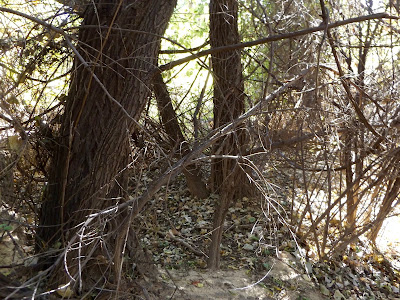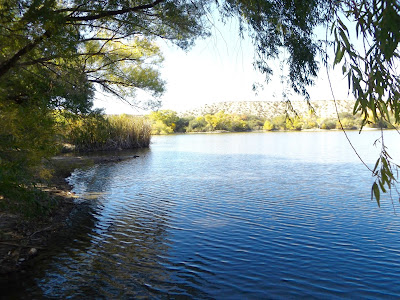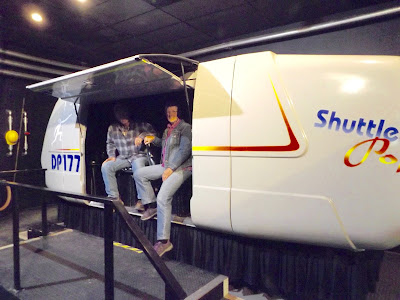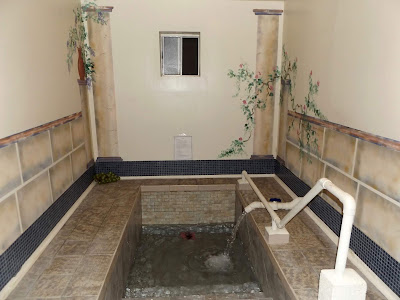December 1, 2019
Here’s a new experience: white light outside and dark inside. Our day-after-Thanksgiving storm has brought great volumes of snow, an idyllic scene upon awakening, and is continuing to live up to the weatherman’s forecast.
Visibility is limited to across the street; the world beyond our little enclave no longer exists, in sight, at least. The power stayed on long enough for the coffee maker to offer up its morning beverage, but then three bumps and it was gone, along with any internet connection. I decided to tax my computer’s battery and bat out a few thoughts as long as it was willing. Next I’ll move on to that book I’ve begun and set aside.
What a good thing it is that we were disinclined to tackle black Friday sales! It will be interesting to learn what transpired this morning at the various emporiums. Those who may have ventured out will not have to endure hordes of shoppers, surely.
And speaking of venturing out, we and friends went day trippin’ earlier in the week when we were blessed with sunshine, if not exactly balmy weather. Loading up with layers of jackets, scarves, gloves and assorted items to keep the cold at bay, and saying goodbye to a dawn-light-washed Thumb Butte . . .
. . . off we went for a bit of an explore, primarily planning to share some fave places with our friends.
The view from the back seat:
When we four-wheeled into the Hassayampa River and walked up-canyon, we found it to be downright early-morning-chilly in the shadowland beneath the cliffs. Somehow, we had departed our vehicle without much of our outerwear. On later stops, we made it a point to dress appropriately.
The shadowy depths enhanced the wintry scene; unlike much of the Hassayampa’s course, that section has a nice little flowing stream. The river’s name translates to something like “the stream that flows underground”; that is my loose translation, anyway.
A road of sorts follows the canyon bottom. There is ample evidence of previous hydraulic mining along the Hassayampa: huge deposits of river gravel line the banks. That type of mining is death to any riparian area. One company has more recently taken up the practice; however, their current efforts are farther back from the riverbed. They are carving away the mountainside and evidently sluicing that material to extract the gold ore.
At another stop, we all wandered aimlessly heads-down as we perused the surface for evidence of previous habitation. That site was a prehistoric winter camp, so explained the señor, and is littered with potsherds from those activities.
While we were in the Hassayampa’s canyon and thereabouts, we identified a few birds: Raven, dark-eyed junco, Woodhouse’s Jay, white-crowned sparrow, black phoebe, red-shafted northern flicker and a brilliant cardinal.
We sidetracked over to a tank where the well pump is now powered by solar energy, sidelining its long-standing windmill . . .
. . . and had some interaction with the avian life there. A beautiful flock of western bluebirds seemed to be as interested in us as we were of them. Their curiosity kept them coming closer and closer as if to look us over. I was sadly unsuccessful in getting a good shot of them, but will include what I came up with. They really were quite charming in their curiosity.
After a lunch stop in Congress (the weather really did not seem conducive to picnicking), we headed off on the Walnut Grove Road where we made the obligatory stop at a ranch pond, complete with picturesque but decorative-only water wheel, and its always abundant waterfowl.
The Gold Bar, cheese and finally the Williams place . . .
Our next destination was, we thought, the Gold Bar Ranch, so that is where we met with our old friend and rancher Ella McCracken. There we learned that Ella has ceased offering trail rides, although her nice bed & breakfast cabin is still open as is her fishing pond with RV sites.
Her passion has turned toward cheese making, it seems, so after we visited the historic Walnut Grove burying ground out on the Gold Bar, we went with Ella over to the nearby Hassayampa Vineyards and Farm, where she is the self-proclaimed “dairy queen”.
For a long spell, we have sought access to what is now the Hassayampa Farm. We believe from family lore that my kinsman, Robert Williams, once ranched there and we were curious about any buildings from his era. He left Prescott for that vicinity in the 1940s. Despite having both legs amputated because of disease, Robert drove the local specially-equipped school bus and maintained his own livestock and garden operations.
Robert’s niece & nephew - my Aunt Margaret and her brother Johnny - told me about going to his place out there on the Hassayampa River, but despite various attempts, we were not able to get into the posted private property - until now. From what we could learn, there is no structure remaining from those days, so getting a photo of the historic Williams homestead seems not to be possible.
Following Ella down the long lane to the ranch’s headquarters, we were amazed to see the large acreage that has been planted to well-tended grape vines. We had heard that some Verde Valley wineries obtain their grapes from that source. It’s clear they are making that enterprise a priority.
The small dairy operation is Ella’s focus, though, and she was enthusiastic in giving us a tour of her domain. At present, they are milking only eight Jerseys, but have plans to enlarge and enhance the cheese making aspect.
That was my first up-close and personal experience with the process of raw milk to cheese. Ella’s experience with and love of her vocation translated into our excitement over purchasing some of the finished product.
She demonstrated how the transformation takes place: from the adjacent milk parlor to the walk-in refrigerator, as she showed us the various vats and presses, tools and equipment. Her passion for the process was wholly contagious - what a charming and fun person she is.
Her products include Hassaigo, mancheco and Hispanico. Shelves loaded with wheels of cheese are the result of her efforts; those that we sampled were downright delicious.
Happily, we had brought along a cooler, so we were all set to bring home some of that made-with-love cheese.
We learned from Ella that Hassayampa Farms may no longer be selling their cheese at the Prescott farmer's market; however, a call to her and a visit to that fine country could net you a supply. Her contacts are (928) 427-6445 or hassayampaVF@gmail.com.
And if you've a yen to stick around, there are the Gold Bar Ranch's bed & breakfast, tent camping and RV sites on the lake: details at www.goldbarranchbb.com. Tell her Rita sent you and I will receive absolutely nothing except knowing you had a great experience.
Hidden no longer . . .
Because that stop was so much longer than anticipated, and so delightful, we altered our itinerary to take in only one more site and to get a walk in the process. That was at the so-called Hidden Tank, an accurate identification but one that fails to convey the surprise at finding a virtual lake out in the middle of an arid plain.
We chanced on that place a few years back: as we were tootling along on Highway 93, I spied something off in the distance that looked a bit unusual amongst many miles of creosote and catclaw (or wait-a-minute vine, as my ol’ pappy called it). We scouted a route to take us in that direction and were astounded at the many acres of water impounded behind large dirt dikes.
Surprisingly few waterfowl were present: on the far side, we spotted a small mixed flock of American avocets and California gulls.
Tom & Pam were also duly impressed at the unexpected sight. We enjoyed a nice leisurely walk along the dam and out into the surrounding plain. We had discovered previously that it is not possible to closely circumvent the lake because the upstream side is so marshy, but we circled out past that morass to drier ground; even there recent rain had turned the ground surface into a slimy mess, much of the resultant bootsole accumulation is now dried onto Ruby's floorboards.
While in that vicinity, we identified a black-throated sparrow and a hairy woodpecker. I have determined to return there during this winter to do more birding and to wander out into the surrounding plains and hills.
Ghost town trio . . .
Our jaunting partners had never been to the Rich Hill region, a lack that we endeavored to remedy by taking our return drive to the east of the highway and climbing back into higher country via the older route - a dirt road that had recently been graded, much to our delight. It's a whole lot of jarring washboard otherwise.
The short winter day did not leave us enough daylight to do much more than stop at Stanton and drive past the other once-booming settlements. Because my grandparents, Zack & Pearl Kelley, homesteaded in 1930 at the foot of Rich Hill, the area has been the focus of plenty of exploring on our part and written about here before, so I will not too much repeat myself now.
Three major communities once thrived there: Stanton (named for its founder, an excessively notorious fellow), Octave (where my parents first met) & Weaver (so called in acknowledgement of Pauline Weaver, an early pioneer thereabouts). The last two are nothing more than piles of rubble now, but Stanton was preserved from vandalism through the years by private ownership and fencing. It is currently owned by a mining club and is open to wander through several of the original buildings.
True to its name, the Rich Hill region was the site of extensive gold strikes. I remember wandering freely through that country in my younger years, but the heightened value of gold has resulted in most claims being reworked and fences to be erected.
Chris made a valiant effort to plunk out some tunes on a piano; however, it was not only out of tune, it was virtually unplayable.
For a long time, the drive down winding Yarnell Hill has offered a look at a huge enterprise visible on the flat far below. According to the signage we spotted as we set off on the old road, what was once Parker Dairy Farms is now something called "Healing the Earth". I give them kudos for such a noble goal, although I am left wondering just how they plan to achieve it. Evidently, a "green planet group" is touting "the future of food" - an abundance of verbiage at that self-titled research, development & training center. Your guess is as good as mine.
Meanwhile . . .
Some time prior to the great Prescott Thanksgiving weekend storm, Barbara invited me to join her in the nearby Granite Dells, one of my most revered sites and one of great interest as development threatens the pristine many-bouldered wilderness.
Hard-working volunteer trail builders have been as busy as an autumn ant colony in there: the primary walking/biking route follows the former Peavine railroad bed along the east side of Watson Lake and through the rocks, but now there are multiple loops branching off from it. Some go down to the water's convoluted inlets and others climb circuitously through the back country.
Barbara and I chose the upward reaching routes; she interpreted a few posted trail maps along the way, while I just smiled and nodded - happy to be out there in good company on a delightfully bright sunshiny day (. . . and now that song's lyrics are going to be running through my mind all day).
The photos might convey a bit of the heart-lifting energy to be experienced out in Arizona's incredible beauty.
That place lures a person on with its myriad rocky alcoves, secreted passageways and jumbled boulders. As the light plays across the granite surfaces and illuminates the autumn-dried vegetation, the scene transforms from one minute to the next.
Somewhat like the bluebirds at the Hassayampa, a small herd of eight deer exhibited at least as much interest in us as we did in them.
It's the little things . . . and there are so many of them.
















































































